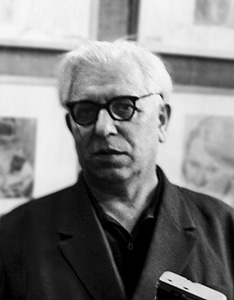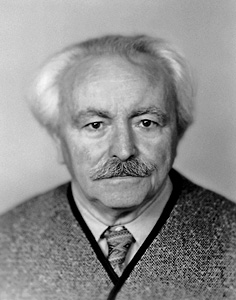Second floor
The second floor of the Institute of Russian Realist Art displays the Soviet art collection of the second half of the 20th century. At its centre are works by the major painters of the 1960s including "National Artists", and full members of the Russian Academy of Arts Gely Korzhev, the brothers Sergei and Alexei Tkachev, Viktor Ivanov, Petr Ossovsky, Dmitry Zhilinsky and Tair Salakhov. The painters of this generation have continued the traditions of Russian artistic culture, and many of them, like Viktor Popkov, have dedicated their works to dramatic events in the contemporary life of Russia, with all of its difficulties and contradictions.
First floor
The halls of the first floor familiarise with present-day life in Russia, including works by such famous members of the Moscow school of painting as Viktor Kalinin, Alexei Sukhovetsky, Vladimir Telin, Nikolai Zaitsev, Vyacheslav Stekolschikov, Nikolai Solomin; the works of outstanding Leningrad painters Andrei Mylnikov, Yevsei Moiseenko, Boris Ugarov, Vyacheslav Zagonek; the artists from Vladimir, including Kim Britov, Vladimir Yukin and Mikhail Izotov. Works by artists from Kostroma, Yaroslavl, Vologda, Vyatka, Sergiev Posad, Krasnoyarsk, Nizhny Novgorod and other Russian cities are also on display.

Peredvizhniki, often called The Wanderers or The Itinerants in English, were a group of Russian realist artists who formed an artists' cooperative in protest of academic restrictions; it evolved into the Society for Travelling Art Exhibitions in 1870.

The State Tretyakov Gallery is an art gallery in Moscow, Russia, which is considered the foremost depository of Russian fine art in the world.

Vladimir Alexandrovich Gorb was a Soviet Russian painter, graphic artist, and art teacher. He lived and worked in Leningrad as professor of the Repin Institute of Arts, was awarded the title of Honored Art Worker of Russian Federation, and was member of the Leningrad branch of Union of Artists of Russian Federation. He is regarded as a representative of the Leningrad school of painting, most famous for his portrait paintings and Art teaching.

Mikhail Davidovich Natarevich was a Soviet, Russian painter who lived and worked in Leningrad; he was a member of the Leningrad Union of Artists, and was regarded as one of the brightest representatives of the Leningrad School of Painting.

Nadezhda Pavlovna Shteinmiller was a Russian Soviet realist painter, graphic artist, art teacher, scenographer, and stage designer who lived and worked in Leningrad. She was a member of the Leningrad Union of Artists, regarded as one of the leading representatives of the Leningrad School of Painting.
Zlata Nikolaevna Bizova was a Russian Soviet realist painter and graphic artist, who lived and worked in Saint Petersburg. She was a member of the Saint Petersburg Union of Artists and is regarded as one of representatives of the Leningrad school of painting.
The year 1957 was marked by many events that left an imprint on the history of Soviet and Russian fine arts.
The year 1956 was marked by many events that left an imprint on the history of Soviet and Russian Fine Arts.

Soviet art is a form of visual art that was produced after the October Socialist Revolution of 1917 in Soviet Russia (1917—1922) and the Soviet Union (1922—1991).
The year 1958 was marked by many events that left an imprint on the history of Soviet and Russian Fine Arts.
The year 1960 was marked by many events that left an imprint on the history of Soviet and Russian Fine Arts.

The Leningrad School of Painting is a phenomenon that refers to a large group of painters who developed in Leningrad around the reformed Academy of Arts in 1930–1950 and was united by the Leningrad Union of Soviet Artists (1932–1991).
The year 1954 was marked by many events that left an imprint on the history of Soviet and Russian Fine Arts.
The year 1973 was marked by many events that left an imprint on the history of Soviet and Russian Fine Arts.
The year 1977 was marked by many events that left an imprint on the history of Soviet and Russian Fine Arts.
The year 1926 was marked by many events that left an imprint on the history of Soviet and Russian fine arts.
The year 1928 was marked by many events that left an imprint on the history of Soviet and Russian Fine Arts.
The year 1942 was marked by many events that left an imprint on the history of Soviet and Russian Fine Arts.

Third National Art Exhibition "Soviet Russia" became a main national art event of 1967, as well as one of the largest Soviet art exhibitions of the 1960s. The exhibition took place in Manezh Exhibition Hall.

The fine art of Leningrad is an important component of Russian Soviet art—in the opinion of the art historians Vladimir Gusev and Vladimir Leniashin, "one of its most powerful currents". This widely used term embraces the creative lives and the achievements of several generations of Leningrad painters, sculptors, graphic artists and creators of decorative and applied art from 1917 to the early 1990s.
This page is based on this
Wikipedia article Text is available under the
CC BY-SA 4.0 license; additional terms may apply.
Images, videos and audio are available under their respective licenses.











